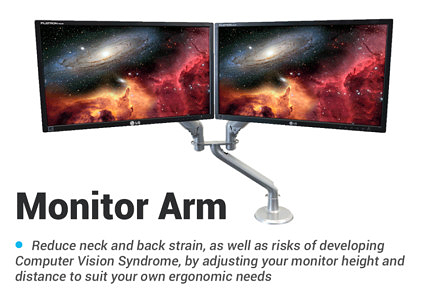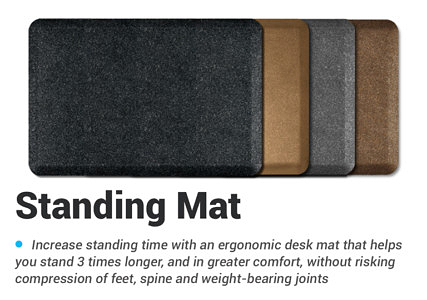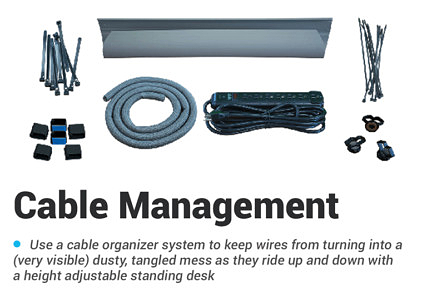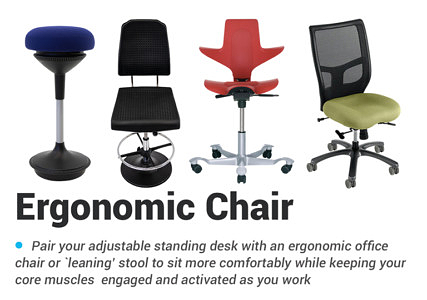3M AKT150LE Adjustable Keyboard Tray Review
- Lab tested
Like most reviews sites, our editorial staff and laboratory testing expenses are partially offset by earning small commissions (at no cost to you) when you purchase something through those links. Learn More

Overview
| Review Summary |
This is a solid tray with quite a bit of adjustability, but it won’t work well with most adjustable-height desks because of the 23” track length. You can potentially install it sideways as a workaround (like we did) but that’s not ideal because it limits the tray’s flexibility and adjustment range, as well as the use of its glide track to stow the keyboard under the desk (you can “pivot” it underneath, however, as part of the workaround). |
|---|---|
| Best Use |
If you need an adjustable keyboard tray for a sitting-height desk. |
| MSRP / List Price | $227.64 |
| Street Price | Scan for available discount deals |
| Warranty |
Lifetime warranty on keyboard arm, 5-year warranty on keyboard tray, and 1-year warranty on the wrist rests. |
| Adjustment Range |
Height range: 6″ below desk to 4″ above desk |
| Dimensions |
Keyboard tray: 19.5″ x 10.625″ |
| Product Weight |
18.5 lbs |
| Competition | Top-Rated Ergonomic Keyboard Tray Reviews |
| User Reviews | See reviews on Amazon |
| Where to buy |
Buy on Amazon |
Rating
| Ease of Assembly | |
|---|---|
| Stability | |
| Reliability | |
| Ergonomics | |
| Innovation | |
| Value | |
| Positives | The AKT150LE is height adjustable from 4” above the desktop to 6” below it, offers +10° to -15° of tilt, and features independent tilt adjustment for the mouse platform. Both the keyboard and mouse platforms can slide horizontally, and the entire platform can pivot 360°. Adjusting the tilt angle and height of the arm is extremely easy, unlike poorer designs we’ve tested, and the built-in position gauges make it a breeze to dial-in. The arm has a lifetime warranty. The brightly-colored mouse pad purportedly saves 50% of battery life on wireless mice. |
| Negatives | The 23” rail won’t work on most adjustable-height desks. Installation requires laboriously drilling pilot holes and driving screws into the underside of your desk. The keyboard platform is hollow plastic and many users complain of outgassing and decomposition of the injection molded plastic material. The horizontal sliding is nice for fit, but it can’t be locked down and slightly destabilizes the structure. The platform has only a five year warranty and only one year on the gel rest, but their material quality is so poor that 3M actually offers replacements for this assembly like the blades on an electric razor. |
Bottom Line
Review
We’ve lab-tested dozens of keyboard trays on standing desks and treadmill desks over the years, and pay particularly close attention to their installability and stability—because most trays, and the AKT150LE is no exception, were really designed for fixed-height desks, and not the ergodynamics of sit-stand desks (Read our primer on adding adjustable keyboard trays to standing desks for more information). So for the same reason that monitor arms are frequently returned by standing desk users because their operating range was designed decades ago to only meet the needs of fixed-height desk users, adjustable keyboard trays tend to have high return rates as well. Save yourself a lot of hassle and frustration by checking out our Comprehensive Guide to Ergonomic Keyboard Trays for Standing Desks before you buy.
The main goal of an adjustable keyboard tray is to fix two common ergonomic problems, elbow flexion and wrist flexion. Elbow flexion is holding the elbows at too sharp an angle. This is where height adjustability helps. Wrist flexion is bending the wrists too far back toward the forearm. This is where negative tilt helps.
With a range from four inches above the desk surface to six inches below and tilt ranging from +10° to -15°, the AKT150LE tray has solutions to both of those issues. This makes it a highly effective adjustable keyboard tray for conventional, fixed-height desks, but one that isn’t well suited for adjustable-height desks because of the rail length (we discuss more about this below).

The ability to raise up above the desk surface does make this an interesting option for a tall user who is having trouble getting their keyboard high enough even with their desk at maximum height. Anyone who wants their keyboard higher than their existing desk can reach should be interested in this tray. That said, there are several desks on the market today designed specifically for taller users and treadmill desk users that’ll offer a much more stable and ergonomic solution, if you’re in the market for a new desk.
‘Negative Tilt’ Explained

This is perhaps the single most important concept that many users, and even salespeople and websites that sell keyboard trays, get reversed in their minds, and it’s easy to understand why this happens. The very word “negative” sounds counter-intuitive. But, in fact, it’s a negative tilt, as shown in the photo on the right, above, that you want to achieve with an ergonomic keyboard tray. The only application for positive tilt is typically for gamers who want to lean way back in their chairs and still be able to see and reach their keyboards.
In general, keyboard trays allow you to tilt the edge of your keyboard that’s closest to the user up, bringing it into a negatively-inclined position from the perspective of where your wrists are resting on the user edge of the keyboard. While this may depart from old-school, pre-ergonomic keyboard design (pop-up tabs on many keyboards used to let you elevate the back—a humongous ergonomic no-no) it’s actually ergonomically proper to tilt the keyboard the other way.
It’s only by placing the keyboard at a negative tilt that wrist flexion—and consequent squeezing of the carpal bones that surround the nerves and blood vessels that pass through them—can be neutralized. For those adding an adjustable keyboard tray to a treadmill desk, you’ll want even more tilt than when at a standing desk. We’ve never been able to figure out how the computer industry started down this path of tilting keyboards in exactly the opposite direction as is ergonomically correct; the myth has persisted for decades and millions of computer users are still unaware.

Adjusting tilt with the AKT150LE is very easy, with a rotating handle that turns easily and is comfortable to reach from most positions. There’s also a gauge showing the current degree of tilt and height setting. That could come in handy if multiple people are sharing a workstation and want to get their tray back to a known spot quickly.
Conclusively Not a Great Fit For Adjustable-Height Desks
The main issue is that this tray isn’t suitable for standard installation on most adjustable-height desks. The rail is 23” long and since most adjustable-height desks have a crossbar under the desktop to add stability, there simply won’t be space to install this tray on most adjustable-height desks in a standard fashion.
On most standing desks there isn’t enough “free draft” under the desktop, i.e. free space between the user edge of the desk and the crossbar, to accommodate a long rail. Other keyboard trays we’ve reviewed that were truly designed for sit-stand desks require much less draft, such as the SteadyType Exo (8”), iMovR Trackless (9.4”), and Humanscale Float (12”).
As a workaround, we mounted the rail sideways in order to get it to fit on our test desk (an UpLift V2). You should install the track right at the edge of your desk if you’re using this method so you can use the arm at its maximum height and so the arm won’t bang on the desk edge every time you raise it above the desk surface.
One drawback of this mounting approach is that the arm sticks out from the desk more than 18” in this form and there’s no way to adjust it. This may make it difficult to get the correct focal depth from your eyes to your monitor(s). It will also increase the “moment lever” that typing on the keyboard will induce on any two-legged standing desk, likely leading to excessive shaking in the desk and up the monitor arm to your displays.
While this approach ostensibly eliminates the ability to retract the keyboard by sliding it backwards on its glide rail, because the AKT150LE has a 360° pivot ability, on a wide enough desk (typically 48” or greater) you can slide the keyboard all the way to one side and then rotate it underneath the desk. (This is fundamentally how iMovR’s Stowaway Standing Desk Keyboard Tray works.) You just have to make sure you don’t run into anything else under the desktop that might interfere with the free movement of the tray platform, such as any desk controllers or top support arms. The bracket does stick down quite a bit when stowed, so watch your knees, too.
Installation
There are a couple of things to note about assembly. The track doesn’t come with the end stopper installed, so take care when you pick it up because the arm could potentially slide out the end, and it is heavy. There are spring-loaded, sharp and heavy metal parts involved in this mechanism, so if you’re not careful when moving them about you could easily get injured… be cautious.
The other thing to remember is the arm and track are pre-lubricated. This is a good thing for ease of use, just be sure to set the arm on a piece of cardboard or something disposable, instead of a desk or any surface you don’t want grease on.
Beyond those notes, assembly is straightforward, involving attaching wrist rests and the mouse platform to the keyboard platform. We found it difficult to get the screws started when attaching the keyboard platform to the arm because there was paint in the threads. This was minorly frustrating and made us stop to double check if we were using the correct screws.
The track then must be screwed to the underside of the desk surface. As we’ve mentioned in other reviews, this installation method results in a very secure connection, but isn’t otherwise ideal. Even if you’re careful, you’re still putting holes in your desk. For example, we caused a bit of damage to the underside of our test desk during removal of the AKT150LE tray when the final screw pulled out under the weight of the tray. This is not unique to the AKT150LE and could happen to any keyboard tray with a similar installation method.

We installed the track with the desk flipped over and would highly recommend that strategy if you’re able to do so. We used a cordless screwdriver to install the rail, as suggested by the assembly instructions.
Finally, you insert the arm back into the track and install the stopper.
Ease of Use
As mentioned above, tilt adjustment was quite easy. The height and pivot adjustments were stiff, but easy enough once you get a feel for them. One of the best features is the lateral adjustability of the keyboard platform. It can slide several inches to the left or right, though unfortunately it has no ability to lock in place. The keyboard platform slides left and right to help you find the ideal position depending on where “typing center” is on your particular keyboard. For example, keyboards with a built-in numeric pad will be centered further to the left versus those that use an external num pad.

The AKT150LE has an independent mouse platform—upgrading it from the AKT60LE we also reviewed. This separate mouse platform (a.k.a. “Lilly pad”) also slides laterally, and can be moved to the left side for left-handed users. The mouse platform can’t be raised above the keyboard platform like more featured lilly pads, so it won’t help attain the ergonomic benefit of reducing the outreach of the upper arm. It does have tilt adjustment independent from the keyboard platform, along with a fence to prevent a wireless mouse from sliding off the platform.
The keyboard platform is 19.5” wide, just barely big enough to support some of the most popular larger keyboards like the Microsoft Natural 4000.
On the whole, the AKT150LE is inconsistent in quality. The arm feels very sturdy and heavy. The wrist rests feel quite nice. But we were disappointed to see the keyboard platform was hollow plastic. The myriad of adjustability options are also detrimental to stability. We read many verified user reviews complaining about the plastic material’s outgassing smell and propensity to decompose and even stain users’ hands over time.
The Company
Buying from 3M means buying from a truly enormous manufacturer, with everything that decision entails. Expect shipping to be prompt, and for owner’s manuals to feature around forty languages. Check the company website for some useful tools, including a video on ergonomics and a comparative chart of their products.
3M claims that the AKT150LE is made from 25% recycled materials, but don’t fool yourself into thinking this makes them green – the company behind the keyboard has consistently ranked amongst the 100 worst American air polluters. Responsible furniture and furniture accessories manufacturers (e.g. Humanscale) have been gravitating more and more towards environmental sensitivity in recent years; 3M has not been following the trend, sadly. (We have not been able to get confirmation yet from the company but suspect the 3M trays are all made in China.)
Other Versions Offered
We’ve separately reviewed the AKT60LE but there are also four other base models of the 3M keyboard trays available. Here’s a table of their basic differences in features:

Warranty
The AKT150LE comes with a lifetime warranty on the keyboard arm, 5-year warranty on the keyboard tray, and 1-year warranty on the wrist rests.
The Takeaway
3M is one of the largest marketers of keyboard trays in the United States, and can be found on Amazon as well as at big box office supplies retailers like Staples and Office Depot (we recommend buying on Amazon for their liberal return policies and convenient return drop-offs).
The bottom line, though, is that all six models were designed for sitting-height desks, not modern stand-up desks. And there are quality issues with all of them that may surprise American consumers who think of 3M as one of the nation’s great innovators (after all, they came up with the Post It Note and Scotch Tape!).
Alas, 3M is most decidedly not a major innovator in the ergonomic keyboard tray arena. These are “me too” products that are old and tired in their design, albeit with many options to choose from. Even on 3M’s own website they generally garner 2 and 3-star reviews.
For standing desk and treadmill desk users there are better products that are more current in their design and deliver the greater stability and ergonomic adjustment range that are critically essential when working at inherently less stable 2-legged desk at standing height extension. Learn about those options in our Comprehensive Reviews of Keyboard Trays for Standing Desks.
What to do when you want to take a conventional keyboard tray off your old fixed-height desk and transfer it to your new standing desk instead? A common issue that people have when installing keyboard trays on standing desks is being incompatible with the crossbar under adjustable-height desks. iMovR’s Keyboard Tray Standing Desk Adapter Kit offers an easy workaround to this problem without sacrificing any adjustability or stability






0 Comments
Leave a response >